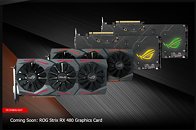Friday, July 1st 2016

ASUS Radeon RX 480 STRIX Pictured
Here are some of the first pictures of ASUS Radeon RX 480 STRIX, the company's premium custom-design RX 480 graphics card. Designed to overcome the power and noise shortcomings of the reference design, the RX 480 STRIX features a custom-design PCB by ASUS which draws power from a combination of 6-pin and 8-pin PCIe power connectors, conditioning it with a strong VRM.
The Radeon RX 480 STRIX from ASUS features the same variant of the DirectCU III cooling solution featured on the company's GeForce GTX 1080 and GTX 1070 STRIX graphics cards, featuring a large aluminium fin-stack heatsink that's ventilated by three fans. This cooler features ASUS Aura compliant RGB LED lighting on not just the cooler shroud, but also the back-plate. Apparently AMD's AIB partners are having better luck at keeping the RX 480's engine clocks above the 1.50 GHz mark, with their custom VRM and cooling solutions.
Source:
WCCFTech
The Radeon RX 480 STRIX from ASUS features the same variant of the DirectCU III cooling solution featured on the company's GeForce GTX 1080 and GTX 1070 STRIX graphics cards, featuring a large aluminium fin-stack heatsink that's ventilated by three fans. This cooler features ASUS Aura compliant RGB LED lighting on not just the cooler shroud, but also the back-plate. Apparently AMD's AIB partners are having better luck at keeping the RX 480's engine clocks above the 1.50 GHz mark, with their custom VRM and cooling solutions.


21 Comments on ASUS Radeon RX 480 STRIX Pictured
PCIe = 75W
6pin = 75W
8pin = 150W
Total = 300W
Even if you go conservative on the PCIe power input and only suck 60-70W from it, that's still over 280W for a 16nm chip with good efficiency. What I think will be the issue here is that chip just wasn't designed to be fastest and super efficient. It was designed to be "good enough" and sell at cheap price because of it. We'll truly know that once Vega gets released. That will actually show how good their architecture really is. That's where they can't just be satisfied with "that's good enough", but they need to spend a lot bigger money on making it a good GPU and pulling a lot more from it, speed and efficiency wise. Damn fall, seems to far away...
I just hope aftermarket boards pull way less from the pci-e slot, those peaks shown in reference card reviews are alarming, and i foresee lots of problems once people go sticking them in 5 year old (or more) motherboards
Personally, how much I even like Asus hardware I don't like the design of this one.
And I did not buy the Asus GTX1070 Strix because it had to be connected to a motherboard fan header.